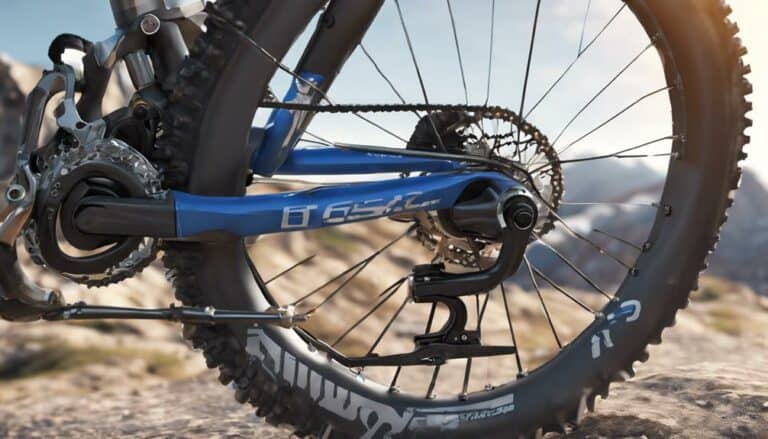Fine-tuning your suspension optimizes handling and stability on rough terrain. Adjust compression, rebound, and preload settings. Balance front and rear suspension for control. Customize damping to enhance traction and maneuverability. This fine-tuning guarantees controlled movement, prevents bottoming out, and optimizes damping characteristics. It keeps your tires in constant contact with the ground, improving stability and responsiveness. Mastering suspension tuning is the key to conquering challenging terrains.
Key Takeaways
- Optimizes damping for terrain variations.
- Ensures continuous tire-ground contact.
- Prevents suspension bottoming out.
- Enhances stability and responsiveness.
- Improves handling on rough terrain.
Importance of Suspension Fine-Tuning on Terrain
Suspension fine-tuning on rough terrain greatly enhances rider control and comfort by optimizing shock absorption and traction. When tackling challenging landscapes, the significance of suspension fine-tuning can't be overstated. By customizing your suspension settings for rough terrain, you're effectively reducing the impact of bumps and vibrations, thereby minimizing rider fatigue and ensuring a smoother overall ride experience.
This fine-tuning plays an essential role in enhancing traction on uneven surfaces, providing you with better control and stability as you navigate through unpredictable terrain. Additionally, by minimizing wheel bounce through proper suspension adjustments, you can maintain better contact with the ground, leading to improved handling and increased rider confidence.
The responsiveness of your bike is also optimized, making it easier to maneuver through obstacles with precision. Ultimately, proper suspension fine-tuning on rough terrain is key to boosting your comfort, control, and overall enjoyment of the ride.
Key Factors for Improved Handling
Enhancing handling performance necessitates meticulous adjustment of key suspension factors on rough terrain. To improve handling and stability, focus on suspension tuning by tweaking compression and rebound settings. These adjustments optimize how the suspension reacts to the terrain, guaranteeing a smoother ride.
Additionally, fine-tuning preload settings is essential for maintaining grip and control on uneven surfaces. By setting the preload correctly, you enhance contact with the ground, improving overall stability.
Balancing the front and rear suspension settings is critical to ensure control over obstacles, reducing the chances of losing traction. Customizing damping settings plays a significant role in absorbing shocks and vibrations, making your ride over rough terrain more comfortable.
Consider the specific terrain characteristics you'll encounter, such as rocks or roots, to tailor your suspension setup accordingly. By focusing on these key factors and adjusting your suspension to match the demands of rough terrain, you can optimize handling and stability for an improved riding experience.
Benefits of Fine-Tuning Suspension
To optimize your performance on rough terrain, meticulous adjustment of key suspension factors is imperative for achieving improved handling and stability. Fine-tuning your suspension offers various benefits that can significantly enhance your riding experience. By customizing compression and rebound settings, you can better control the movement of your suspension, preventing bottoming out and excessive bouncing, thus ensuring a smoother ride over rough terrain. Adjusting preload settings allows you to optimize traction and control, enabling superior maneuverability on challenging off-road surfaces. Moreover, balancing front and rear axle settings is crucial for enhancing overall stability and control, essential when navigating unpredictable off-road conditions. Personalizing your suspension based on your preferences and the characteristics of the terrain can boost your confidence and performance significantly. Embrace the power of fine-tuning to conquer rough terrains with ease and precision.
| Benefits of Fine-Tuning Suspension | ||
|---|---|---|
| Compression | Enhanced damping | Prevents bottoming out |
| Rebound | Controlled movement | Smooth ride |
| Preload | Improved traction | Better maneuverability |
Techniques for Enhanced Stability
For improved stability on rough terrain, precise adjustments to key suspension factors are necessary to optimize your performance. To achieve this, consider the following techniques:
- Fine-tuning Compression and Rebound Settings: Adjusting these settings can help your suspension system absorb impacts effectively, keeping your ride stable and controlled over challenging terrain.
- Balancing Front and Rear Suspension: Ensuring an even weight distribution by balancing both front and rear suspension settings is vital for maintaining stability on uneven surfaces, enhancing your confidence in handling obstacles.
- Customizing Damping Levels: Personalizing your damping levels based on the terrain conditions allows you to optimize your suspension response, reducing vibrations and providing a smoother ride.
Impact of Suspension Fine-Tuning
The impact of suspension fine-tuning on rough terrain can be transformative, enhancing your control and stability to a great extent. By adjusting your suspension, you can optimize damping characteristics to effectively absorb shocks and bumps, thereby improving your bike's handling on challenging terrain.
Tweaking compression and rebound settings plays an essential role in enhancing stability by ensuring that your tires remain in constant contact with the ground, even on uneven surfaces. Customizing preload settings is necessary to prevent bottoming out, increasing your overall control and reducing the likelihood of accidents when trekking rough trails.
Balancing the front and rear suspension adjustments is key to improving stability and responsiveness, which are crucial factors when conquering rough terrain. Moreover, fine-tuning your suspension for specific rough terrain conditions, such as rocky or root-filled paths, can greatly enhance both handling and stability, providing you with a smoother and more controlled ride.
Conclusion
To summarize, suspension fine-tuning plays a pivotal role in enhancing handling and stability on rough terrain.
By adjusting key factors such as damping, spring rate, and preload, riders can optimize their suspension system for better performance.
For instance, a motocross rider who fine-tuned their suspension to match the specific track conditions saw a significant improvement in their lap times and overall control of their bike.
Fine-tuning suspension is a valuable tool for achieving peak performance in challenging terrain.

